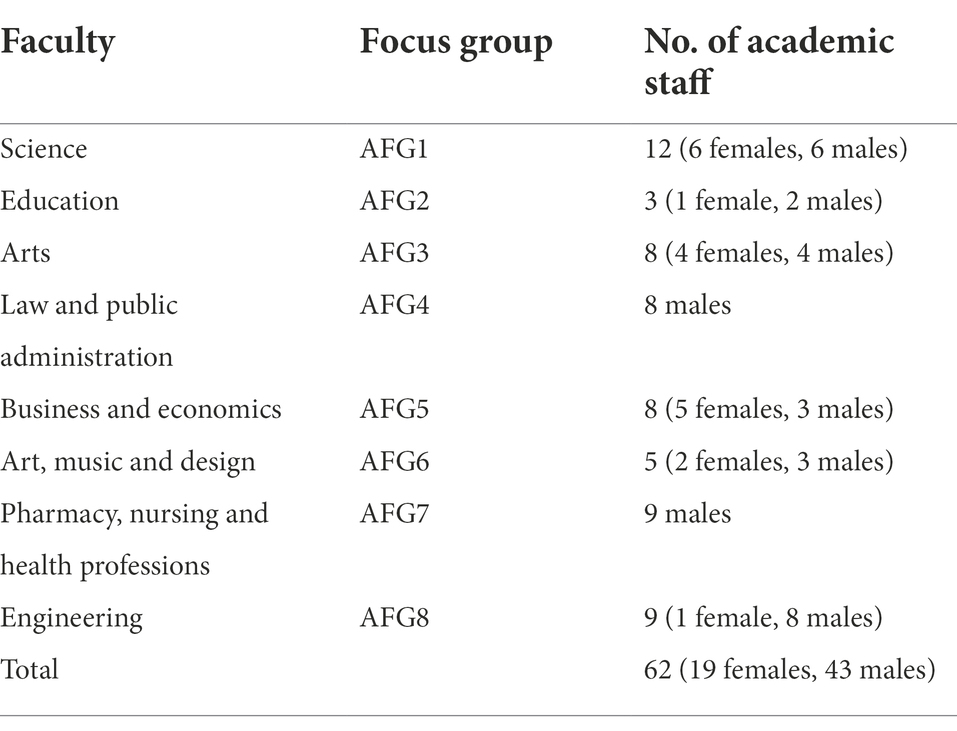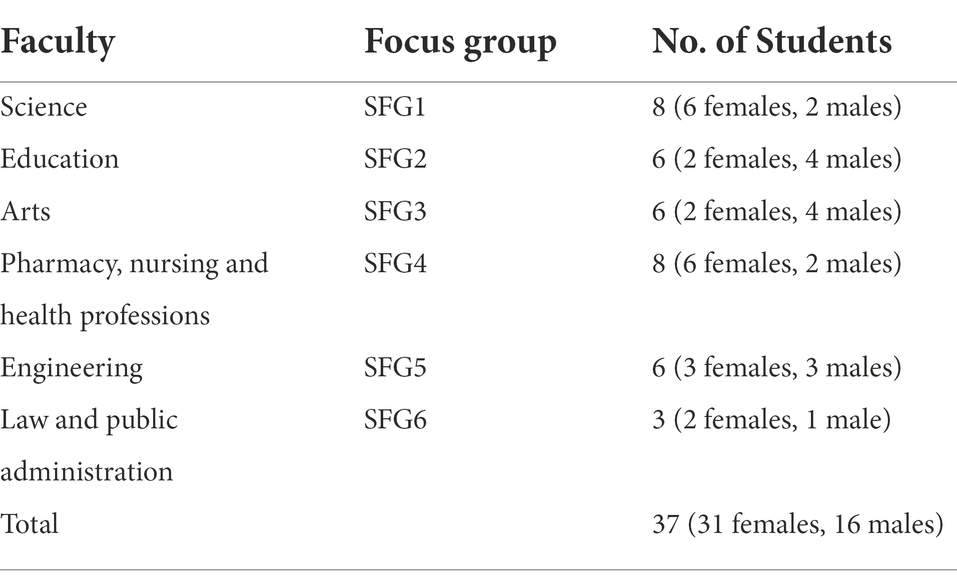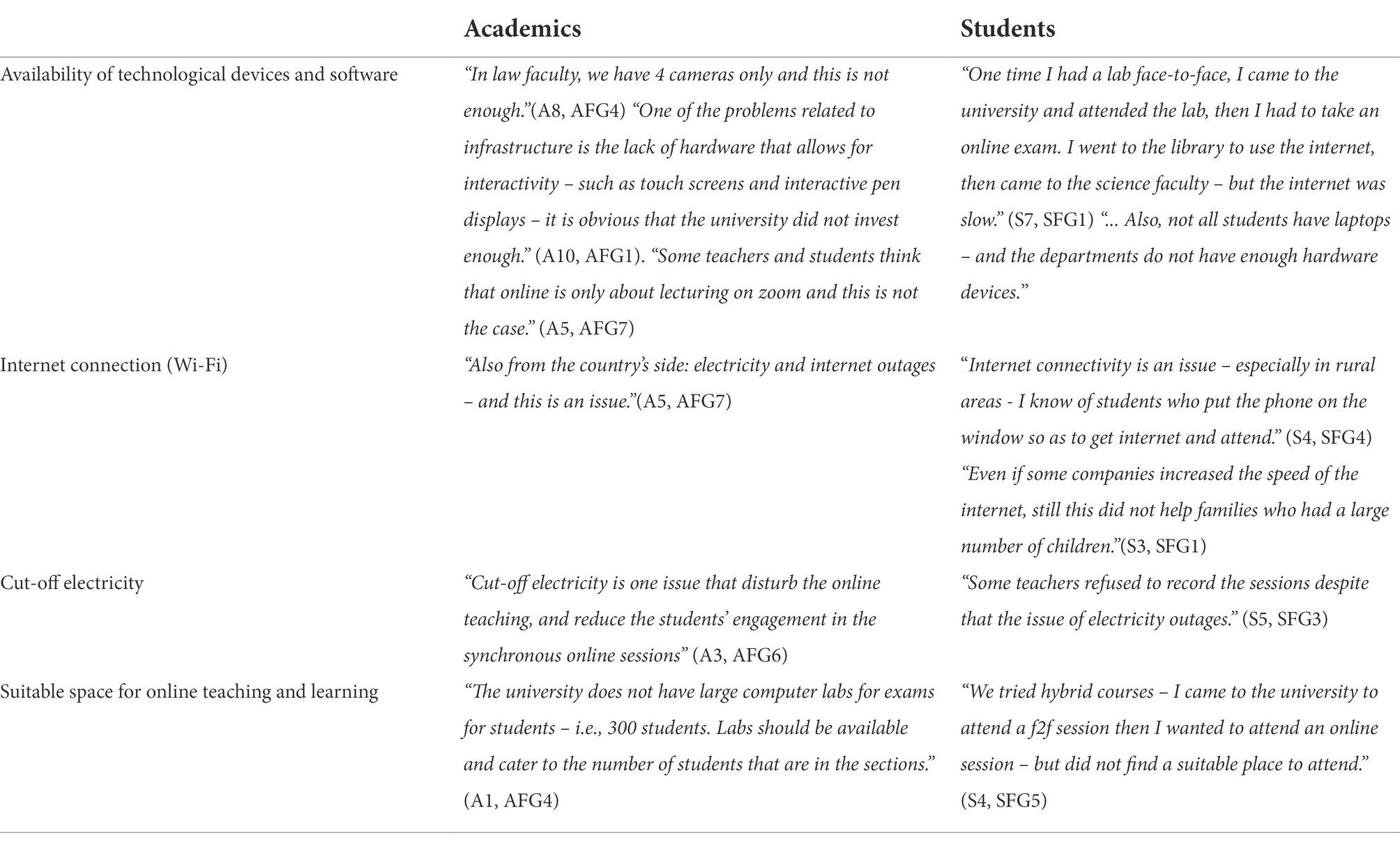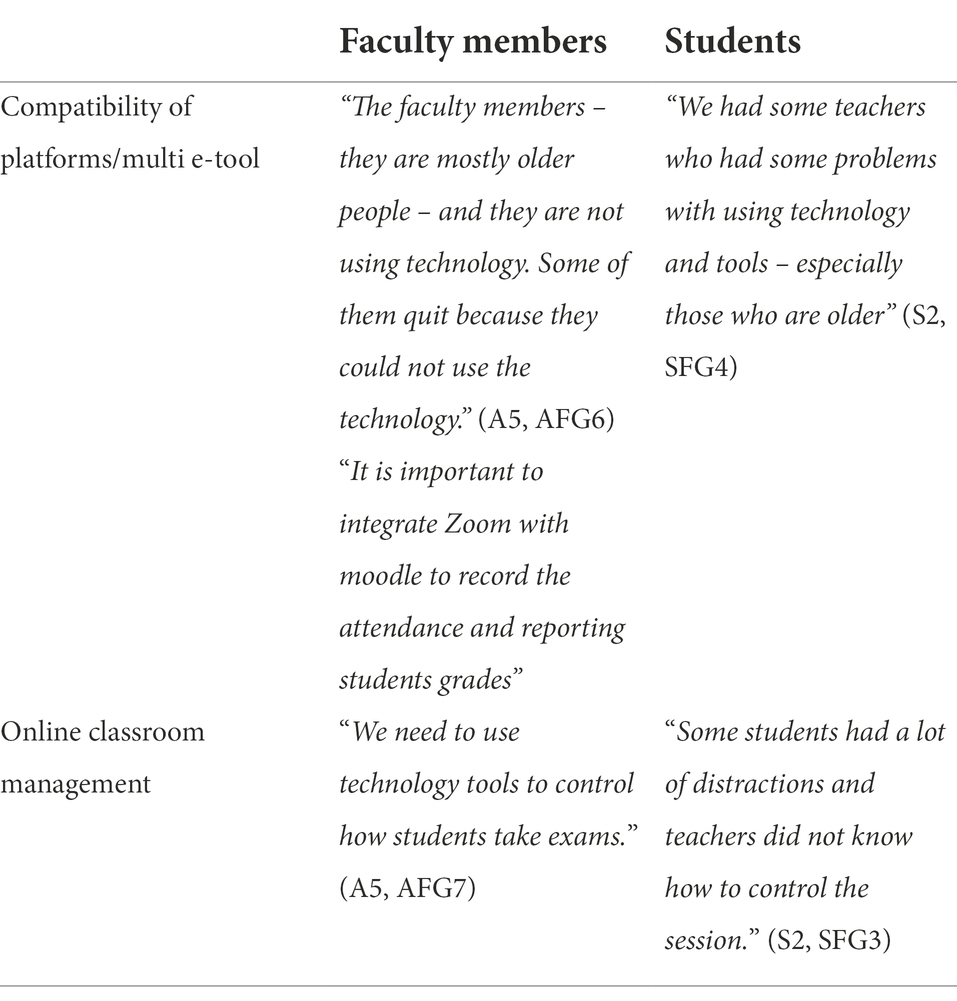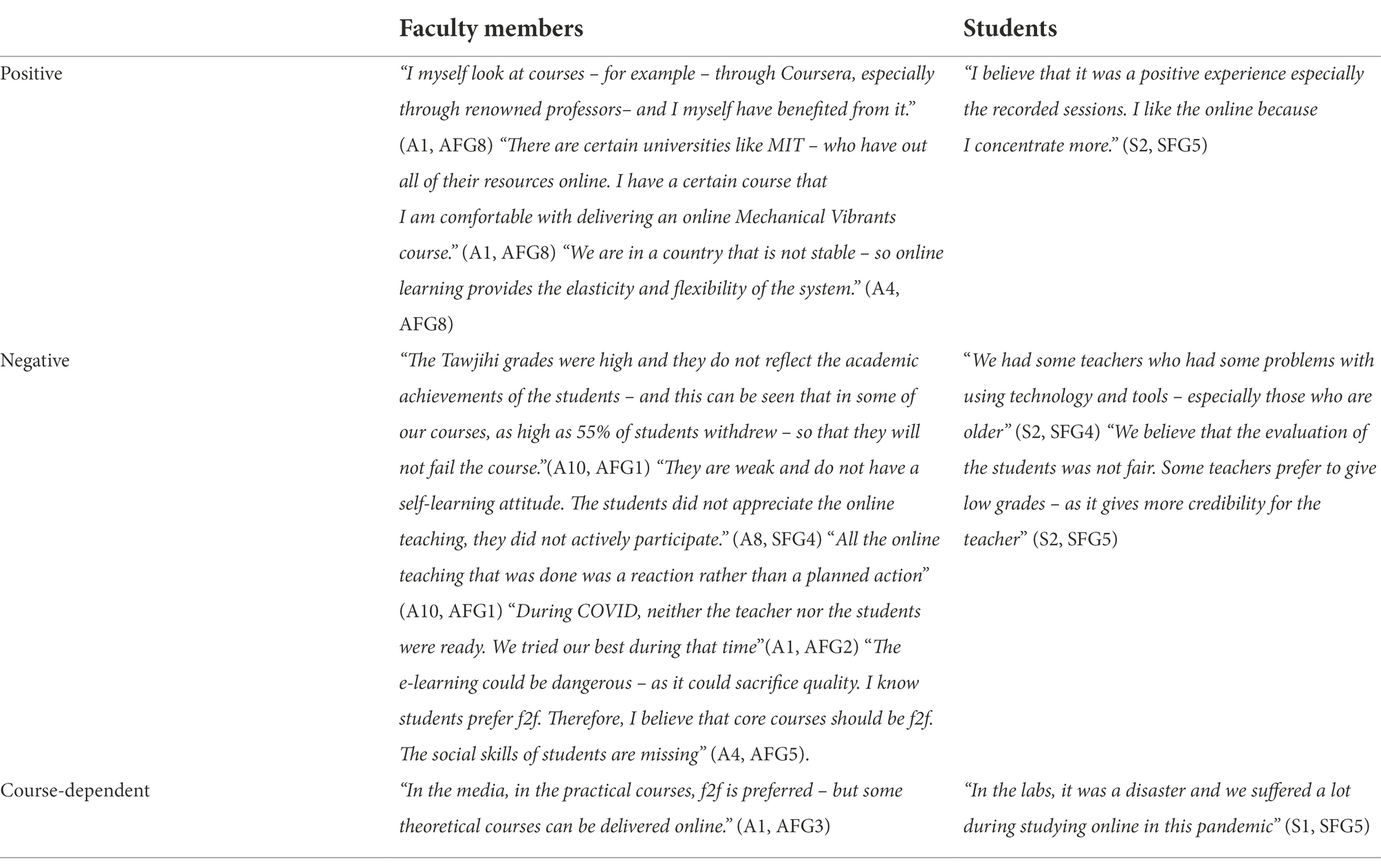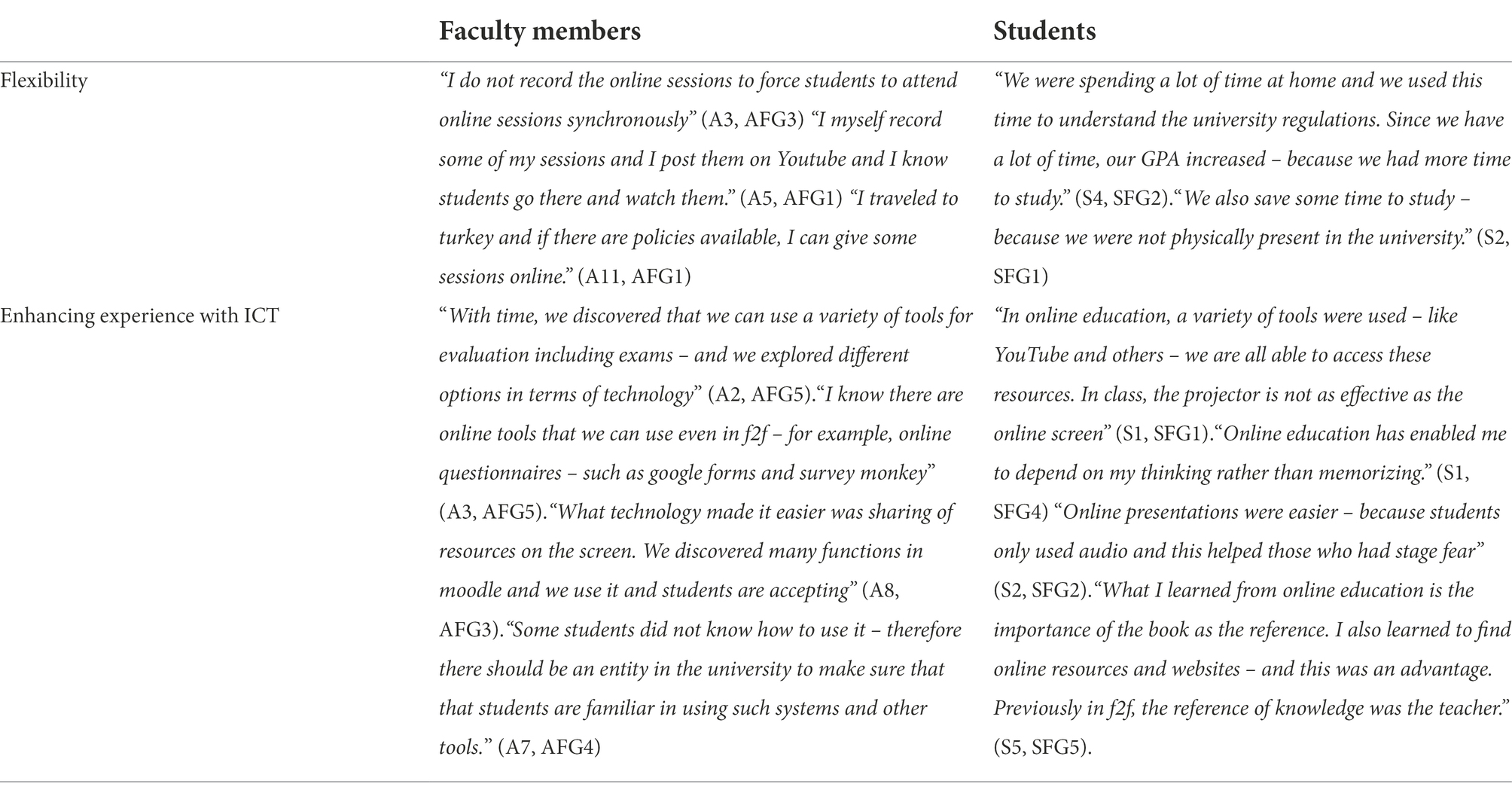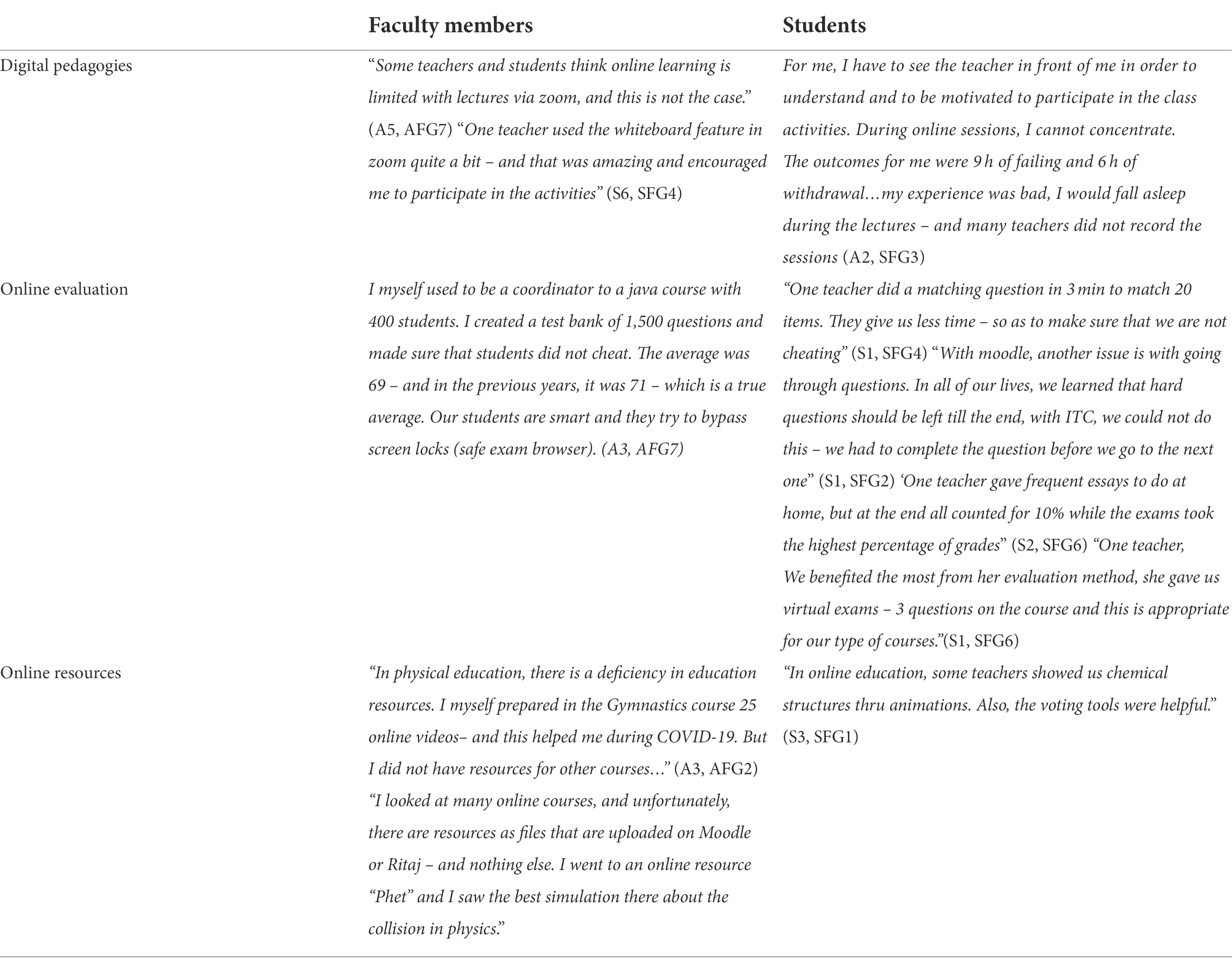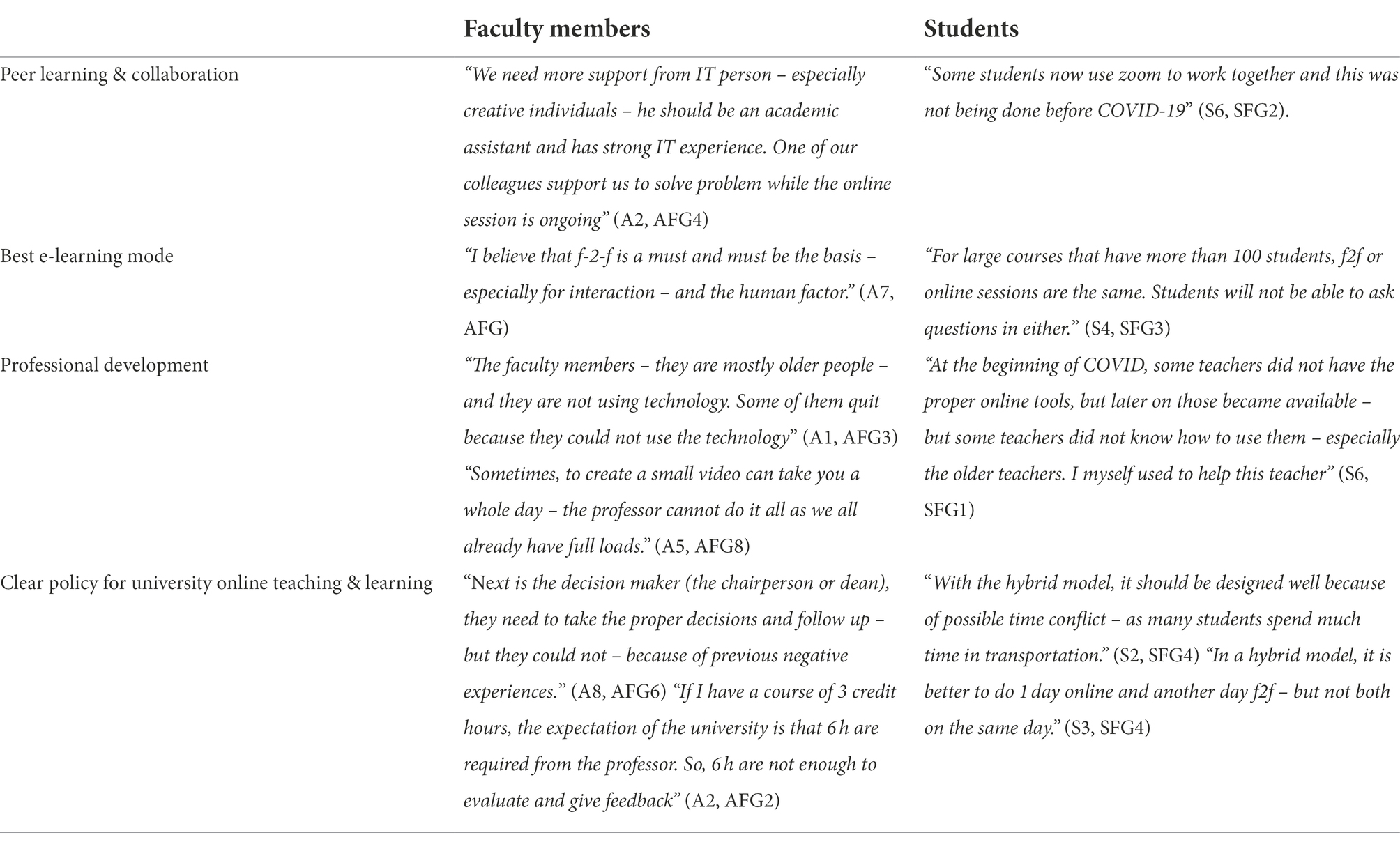- 1Faculty of Education, Birzeit University, Birzeit, Palestine
- 2Faculty of Educational Sciences and Teachers Preparation, An Najah National University, Nablus, Palestine
The COVID-19 crises forced and accelerated digital transformation in higher education institutions. Acceptance of the adoption of digital technologies in those institutions as well as their digital and educational readiness and resilience are important key success factors for this transformation. The objective of this study was to explore challenges, attitudes, opportunities and lessons learned of digital transformation in times of crises at the university level from faculty members’ and students’ perspectives. The study used Unified Theory of Acceptance and Use of Technology (UTAUT) as a theoretical framework. In order to achieve the objective of the study a qualitative method was used. A total of 14 focus group interviews with 62 faculty members and 37 students were conducted in a mid-size university in Palestine. Thematic analysis was used to analyze data gathered from the focus group sessions. Results revealed many challenges toward digital transformation including technical and pedagogical infrastructure, social conditions, ease of use of software, digital pedagogy and online assessment. There are positive attitudes towards the availability of online resources and digitizing theoretical courses. However, students and faculty members still feel that they are not prepared enough for online education and expressed negative attitudes when digitizing practical courses. In order to achieve effective online teaching and learning, good preparation is a must for both students and lecturers which is not followed in actual delivery. Results also revealed several opportunities and benefits of digital transformation, namely, flexibility and the opportunity to develop new technical and educational skills. Researchers recommend carrying out this study in other universities and within different social and cultural contexts and applying mixed approach methodology for validating emerged results.
Introduction
Ubiquitous technology and device access have given rise to digital universal connectivity which is a fundamental element that can help build a sustainable and inclusive education model (Leal Filho et al., 2021). More than ever now, higher education institutions, governments, and private sector organizations are working together to improve digital infrastructure. Smartphone devices, tablets, and chromebooks are becoming powerful and effective tools to bridge the digital divide. Online platforms such as learning destination sites (LDS) and learning management systems (LMS) are transforming learning experiences by allowing the learners to access and download courses, manage and track progress, take notes, and actively participate in discussions with peers and co-learners (Bekova et al., 2021). Virtual communities of practice are empowering faculties to adapt to the evolving pedagogy and course work through resource sharing and curating engaging classroom experiences (Hodges et al., 2020). Digital curriculums are enabling curriculum-aligned, next-generation assessments that can provide automatic grading, support prompt feedback, track reasoning and understanding through strong analytics from different data sources (Ertmer, 1999). Many institutions around the world are embracing these important changes in an era in which the future of education - past the pandemic - will be characterized by blended and hybrid classrooms (Sevnarayan, 2022) with focus on engagement, satisfaction, skill development, and career outcomes - as key education quality metrics (Torres, 2021).
During the past years, the COVID-19 pandemic has posed unprecedented challenges for universities and for the education ecosystem in general. The crisis revealed the vulnerability of the traditional HEI model of teaching that is based on the physical use of the campus for teaching supported by peripheral services (Leal Filho et al., 2021). The crisis also exposed the digital readiness of universities showing that even if digital tools are readily available, the ad hoc use of digital technologies does not necessarily enhance teaching and learning (Ng'ambi et al., 2016). Furthermore, the pandemic highlighted and renewed concerns about socio-economic aspects of inequalities in education as students from rural and low-income families have less access to resources at home (Sims et al., 2008; Oyedemi, 2012).
As the COVID-19 pandemic rapidly spread across countries at the beginning of 2020, the Palestinian higher education ecosystem was severely disrupted and affected. The disruption came as a result of the Palestinian National Authority (PNA) implementing different measures to curtail the spread of the virus from social distancing to complete lockdown of campuses. As university campuses shut down, emergency response teams in universities jumped into action by implementing “remote/distance teaching” makeshifts to keep, at the peak of the pandemic, more than 200,000 Palestinian university students learning. In Palestinian universities, faculty members mitigated the disruption of campus closures caused by the pandemic by moving many of their courses, learning resources, and assessments online (World Bank, 2020) – as part of a necessity rather than a strategy to build resilience into teaching and learning.
Therefore, the transition from on-campus teaching to remote teaching was sudden, unexpected and emergency-driven. Many of the faculty members were relatively new to the online environment and were unsure of how to set up their teaching for success. Because the sudden shift happened in the middle of the semester, the adjustment to the new situation had to be quick - but was difficult to plan - as faculty members had different levels of preparedness when it came to designing and delivering course content in online format.
Students have been particularly affected as they suffered varying degrees of learning losses. Outside the campuses, learning losses may manifest in even greater long-term challenges. Without remediation, learning gaps could stay with the students as they transition to the labor market, potentially exasperating inequality. Furthermore, learning gaps are often compounding which means that if they are not tackled promptly and effectively, students are most likely to fall further and further behind (Torres, 2021).
This exploratory qualitative research aims to understand how the COVID-19 pandemic shaped student and teacher experiences with teaching and learning in a mid-size university in Palestine including lectures, seminars, lab-based courses, practical classes as well as their satisfaction with different aspects of the semesters.
According to the education sector strategic plan (Ministry of Education and Higher Education - MoEHE, 2017), one of the main components of improving higher education in Palestine is expanding and encouraging digitization of education and developing e-learning programs and digital content. Higher education institutions in Palestine as well as higher education institutions worldwide started to recognize digital transformation not only as a matter of enhancing quality but as a necessity and a growing need. The pandemic that imposed a sudden shift toward online remote teaching and showed how much the educational systems are in need for such a transformation.
This study took place in a mid-size university in Palestine targeting both faculty members and students in eight faculties: Art, Music and Design, Art, Business & Economics, Education, Engineering & Technology, Law & Public Administration, Pharmacy, Nursing & Health Sciences and Science. A middle-size Palestinian university has 119 academic programs, 445 full-time staff and about 15,000 students. Since 2006 many digitization initiatives have taken place at the university level but they were mostly individual based and mainly used blended learning strategies. One of the most recent efforts in this regard is the digitization of the whole educational diploma program including 24 courses through a Palestinian-Finnish collaboration project titled: Teacher Education without Walls – New models for STEM and Teacher Education in the Digital age (OLIVE, 2022).
In March 2020, Palestinian universities moved to online teaching as the government has announced a national emergency and closed all schools and universities due to the outbreak of the COVID-19 pandemic. This closure severely affected learning and teaching processes not only on the national- but also the international level (Sun et al., 2022). The crisis showed that educational institutions are not prepared for online learning in terms of pedagogy and infrastructure and that there is a lack of policies that regulate such a digital transformation. Currently the rapid return back face-to-face instruction is also imposing new challenges and higher education institutions are most likely looking forward applying more digital learning and teaching practices within their programs and systems (Abdrasheva et al., 2022).
The purpose of this study was to explore challenges, attitudes, opportunities and lessons learned of digital transformation in times of crises at the university level from faculty members’ and students’ perspectives.
The research results will contribute to the development of a clear and specific policy that will make digital transformation more relevant to digital practices of both faculty members and students. The results will help also identify challenges and solutions that can support the digital transformation in universities within the Palestinian context. In addition, the results will shed light on possible benefits and opportunities of digital transformation that may contribute to the quality of learning and teaching processes in higher education. Improving readiness for future crises in local and international crises, preparing students to contribute to the digital society.
Therefore, three main questions guided this study:
1. What kind of challenges do faculty members and students perceive throughout digital transformation in times of crisis?
2. What attitudes do they hold toward online/blended learning in higher education?
3. What opportunities do exist while moving forward towards online/ blended learning?
Related studies and theoretical framework
Related studies
The current challenges facing higher education globally have provided universities with great lessons that need to be carefully studied. There have been significant challenges such as closure of universities and an abrupt move toward distance education. In Iraq, as in other countries, the global pandemic has caused sudden shock and disruption to many institutions that were not prepared for it (Leal Filho et al., 2021). The reason for the disruption is that the majority of educational systems are fully implemented based on traditional face-face interaction methods. Additionally, technology is not fully developed and still in the process of finding its place in educational practice. However, the pandemic has made it imperative for our universities to make a quick transition from face-to-face teaching to distance learning so that universities can maintain delivery of education material for their students (Bekova et al., 2021). Students in their first years of college may have suffered more than other, more senior peers due to the dual challenge of moving to the new environment of higher education and also applying distance learning (Hodges et al., 2020). The latter requires special experience and technical tools in which new students might be lacking.
Digital technology has been identified as one of the strategic solutions to be utilized in teaching practices to ensure pedagogical continuity for our students (Ertmer, 1999) and teachers (Coulange et al., 2021). This is especially important since the ongoing health crisis may be long-lasting and we may encounter recurring related events in the future. Universities have made great effort and have taken available feasible actions such as using some free and paid services offered by Google Workspace, Microsoft or other professional bodies. Other universities have moved further professionally with purchasing servers and installing their E-learning platforms and inspecting their computer and network equipment for possible upgrade. Another challenge is that the new software and technology tools require sufficient experience so that when implemented they can handle and manage learning resources as intended. Most importantly, the infrastructure of the whole country in terms of networking and internet services is not fully stable and it can be considered the biggest challenge for all (World Bank, 2020; Torres, 2021).
It is irrefutable that remarkable teamwork has been established from all governmental levels in the ministry of higher education and scientific research and institutions themselves in response to this major health crisis. As an example, many training workshops on educational digital and e-learning platforms were organized and held. Furthermore, universities provided great support to students in all aspects of their education to maintain their learning process. Moreover, lecturers have played a pivotal role in delivering the teaching content online using their facilities and resources such as laptops and internet services. Such considerable cooperation between the ministerial level and institutions, lecturers, and students have led to pedagogical continuity. Despite many success stories, a deep reflection needs to be applied.
In the last 10 years, higher education institutions have been experiencing huge changes in different aspects affected by the advanced technologies and social trends towards digitalization. The revolution of digitalization involved all sectors in societies from production to banking (Marcum, 2014). Nowadays, technology adoption by higher education institutions is connected to the paradigm shift which is forced by technology that enables digital learning (Mahlow and Hediger, 2019). In the context of higher education institutions (hereafter HEIs), digitalization of these institutions is a necessity to attract more and better students through improving the courses materials and training materials (Gurung and Rutledge, 2014).
Therefore, digital transformation (DT) has become a necessity for HEIs in the last 10 years, this transformation becomes necessary and natural for HEIs that seek to be leaders of change and be highly competitive in their field. Datta (2020) defined digital transformation as a technology-driven process aimed at strategically disrupting and fundamentally improving existing models and operations to achieve continuity and competitive advantage. McTavish and Filipenko (2016) presented digital transformation as a process that integrates digital technology in all fields and requires changes in the areas of technology, culture, and operations. Brooks and McCormack (2020) integrated it within a deep and coordinated culture, workforce, and technology shifts that enable new educational and operating models and transform an institution’s operations, strategic directions, and value proposition.
DT is the process that integrate technology in all requires changes and aspects of culture, operations, and policy of higher education institutions (McTavish and Filipenko, 2016). In order to exploit emerging technologies and their expansion in human activities, HEIs should adopt technological initiative and be adapted with the rapid changes in technology through changes in its culture and policy to succeed in the fourth industrial revolution which is DT.
Abad-Segura et al. (2020) developed a conceptual structure on the sustainable management of digital transformation in higher education (Figure 1). From the figure, we noticed that the DT process has different phases including digital competence, digital use, and digital transformation.
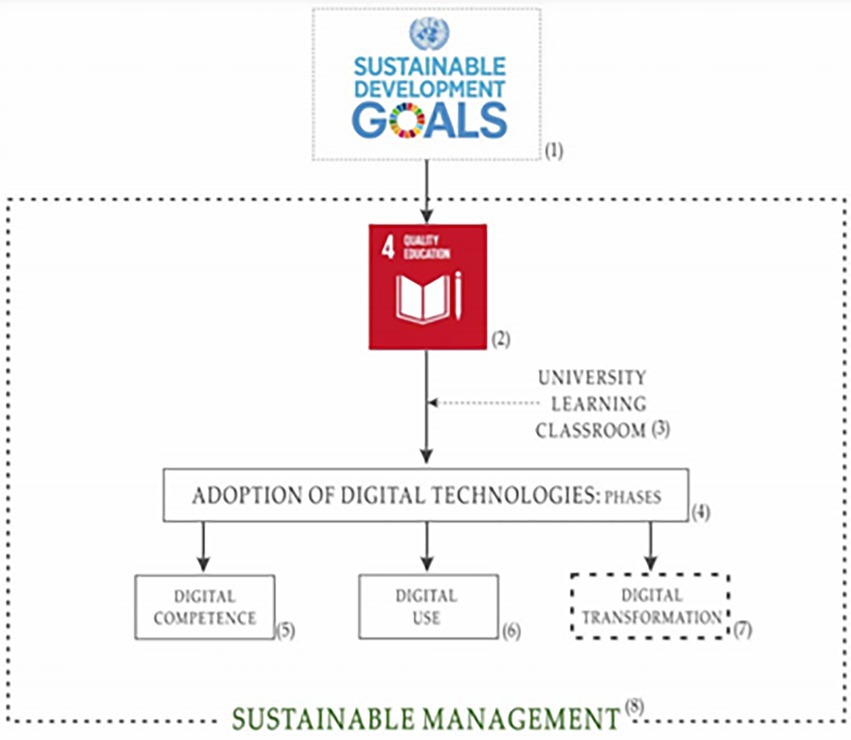
Figure 1. Sustainability development model (Abad-Segura et al., 2020).
Theoretical framework
The framework of this study was Unified Theory of Acceptance and Use of Technology (UTAUT). Venkatesh and colleagues developed the UTAUT model based on previous models and theories such as TAM and TPB. UTAUT model (Figure 2) is composed of four main constructs including: performance expectancy, effort expectancy, social influence and facilitating conditions. Moreover, it has four mediators which are gender, experience, voluntary use, and age. In the context of the study, facilitation conditions refer to the facilitations provided by the institution for the faculty members to teach in online environment during crisis such as professional development and technical support etc. Also, effort expectancy refers to the expected efforts that faculty members need for using online teaching tools compared to the benefits received by that effort. Social influence is related to the peers or other faculty members’ influence to use online teaching. Finally, performance expectancy refers to how using the new technology may enhance the performance of users.
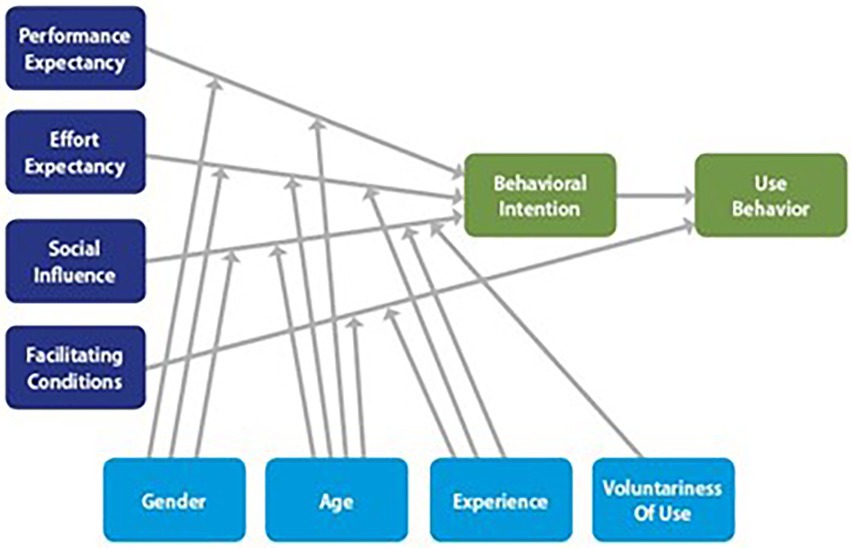
Figure 2. Unified theory of acceptance and use of technology (UTAUT; Venkatesh et al., 2003).
Many researchers did not investigate these mediator variables and their influence on the four main constructs (e.g., Ifenthaler and Schweinbenz, 2016; Khlaif, 2018). Various studies in different contexts have been conducted by using UTAUT to investigate the factors influencing emerging technologies such a mobile technology, artificial intelligence, wearable technology and smart technology (Aytekin et al., 2022; Lin et al., 2022; Mishra et al., 2022). The justification of using the first version of UTAUT rather than the extended ones such as UTAUT 2 and 3 was the variance of prediction of the first version was the highest 70% (Gunasinghe and Nanayakkara, 2021) where the other versions between 62 to 66% (Rudhumbu, 2022; Tetteh et al., 2022).
In order to explore faculty members’ and students’ perspectives toward digital transformation at the university level, it is important to identify their previous experiences, expected benefits and challenges that they have faced during their use of new technologies in learning and teaching processes.
In the context of this study, the research focus group interview questions focused on exploring previous experiences, challenges and opportunities of participants (faculty members and students) in using technology during the pandemic and whether those experiences will help them to attain gains in their university learning and teaching (performance expectancy) and the degree of ease while using those technologies (effort expectancy). The focus group interview method that was used in this study allowed discussions among research participants in order to uncover others’ different opinions and expectations (social influence). In addition, interview questions addressed the degree to which participants believe that the university provided a well-organized and technical infrastructure (facilitating conditions).
Materials and methods
In the current study, the research team employed qualitative approach using focus group interviews to collect data and answer research questions. Focus group is an organized and structured way of data collection with help of a moderator or facilitator of the selected prompts or topics. This research method was recommended to use in social science research for assessing the participants’ attitudes, opinions, experiences and feelings (Morgan, 1996) and thus suitable to accomplish the purpose of this study. In addition, the interaction that happens in the focus groups yields significant data and creates spontaneous responses (Butler, 1996).
Participants
The participants in this study were 62 faculty members and 37 students from different faculties in a mid-size university in Palestine. The distribution of the participants is presented in Tables 1, 2.
Recruitment of participants
The deans were approached to invite faculty members and students from the different departments to participate in the focus group. The invitation for participation for both was made open to any student and faculty member who want to participate in the focus group discussions regardless of their preferences and interest in e-learning. Thus, their participation was voluntary.
A total of eight focus group discussions were conducted in person with faculty members and six focus group discussions were conducted with students.
Development of the research tool
The researchers developed the focus group discussion questions and the prompts used in the discussion sessions based on the research questions and related studies (Hess et al., 2016; Datta, 2020; Ferri et al., 2020; Bekova et al., 2021). Moreover, the researchers generated prompts based on the discussion in the focus group. Some of the focus group questions were: how do you see university teaching and learning changed after the pandemic? What challenges did you face during remote teaching in the pandemic? What opportunities/ benefits of did the use of technology bring to university teaching? How do you think e-learning/ blended learning may affect the quality of university education? How would you expect/ wish university learning and teaching will look like in 5 years from now? What kind of regulations and policies regarding e−/blended learning would you like to have? Would you be interested to attend short training workshops and/ or capacity-building events that address new technology- based university pedagogies?
Some of the prompts generated in the focus sessions were: e-learning after COVID-19 will be completely different from pre-COVID, what do you think? Can you give an example? “Educators developed their technological skills and knowledge during the Great Online Transfer; what do you think?
Data collection procedures
The researchers sent an invitation to the interested participants explaining the objectives of the study and a link of Doodle to allow the participants to choose the best time for them to attend the focus group session. All of the focus group sessions were held in the main Campus of the university. One of the researchers introduced the purpose of the focus group, discussion protocol of the session, and asked permission to record the discussion. Two researchers facilitated and controlled all focus group sessions by adhering to the preparing focus group discussion protocol. They conducted all sessions in person for approximately 40 to 60 min each. One of the researchers was facilitating the discussion among the participants and the second one was taking notes. After each session, the note taker summarizes the main points in front of the participants and asks them if they agree or not or want to add more.
Data analysis procedure
The researchers followed the procedures reported by Braun and Clarke (2019). The researchers firstly met together to develop the coding book based on the findings of literature and the study framework (Appendix A). Thematic analysis (Ivankova et al., 2006) was used in data analysis by following up the procedures suggested by Braun and Clarke (2019). First, reading line by line by the researchers individually. Second, looking for ideas or concepts based on the study framework. Third, grouping the related ideas or concepts with each other. And finally naming the groups as themes and subthemes based on the similarities of the concepts and ideas. After coding all the transcription files, the researchers meet together to discuss the outcomes of analysis to finalize the themes and subthemes. Any discrepancy and disagreement among the researcher resolved by negotiations, where the inter rater reliability was 89%. The themes were expanded and modified during the analysis. This process was continued until no new theme pattern appeared. Data analysis reached saturation when no crucial insights were added (Lincoln and Guba, 1985). To mitigate subjectivity bias and to provide the triangulation, two researchers reviewed and coded the transcripts independently, then they compared the resulting codes, identified inconsistent cases and reconciled.
Trustworthiness
The process of trustworthiness started from the first point of developing the focus group discussion based on the research questions and related studies, in addition, the questions and prompts were sent to a panel of experts. A pilot focus group was conducted to check the understanding of the prompts and questions. Data analysis was conducted individually and at the end inter-rater reliability was calculated 87%.
Results
Challenges that faculty members and students perceive throughout digital transformation in times of crisis
Facilitation conditions
Results revealed four sub-themes of facilitation conditions as major challenges for digital transformation in times of crises: lack of proper technological devices and software, poor and instable internet connection, cut-off electricity and lack of suitable space for online teaching and learning.
The majority of the participants (students and faculty members) reported that there is a lack of hardware (devices such as computer, camera, scanner, touch screen, interactive pen display, and whiteboard) that are needed to support the teaching process in online sessions. Moreover, many students mentioned that the lack of devices and suitable places deprived them from attending online sessions. All of the students who participated in the current study reported that they do not have fast and stable internet connection for online learning. Although few faculty members reported the cut-off electricity during online sessions influenced their teaching negatively, many students mentioned it as a challenge (Table 3).
Social influence
Results pointed out three challenges in terms of social influence: social context, university life, and social isolation.
All faculty members and students referred that the social environment affected online learning negatively in Palestine. This is because of minimal students’ engagement and loss of body language in the online environment. Many faculty members did not turn the camera on during online sessions and/ or during office hours and refused to record their lectures. Also, many students themselves did not open the camera during online sessions. The majority of participants felt that online learning negatively affected students’ university life (skills and social contact), since they were not able to interact in person with each other and within the university campus. Social isolation impacted students’ life and caused stress, headache, and psychological problems as reported by most of the students (Table 4).
Effort expectancy
Results showed that effort expectancy is another source of challenges that included compatibility of multi platforms/ e-tools and online classroom management.
Most of the participants in the study (students and faculty members) complained about shifting of using various platforms and learning Management Systems during online teaching. For example, some faculty members stress the difficulties of using BigButtonBlue “BBB” due to its unfriendly interface and need for high-speed internet. Other faculty members reported that changing and using new technologies takes more time to learn how it works and how to use it especially when it comes to older faculty member. Most participants suffered the incompatibility between university local platform and other video-conferencing tools like ZOOM and BBB. Some students and faculty members reported that lecturers could not manage and control online sessions (Tables 5, 6).
Attitudes toward online/blended learning in higher education
Results indicated participants’ attitudes that can be described as positive, negative and course dependent. As reported by most of participants, those attitudes were affected by their background, experience with ICT, and teaching experience on online teaching.
Some participants mentioned that online learning can be effective and beneficial for students and teachers, and it is the time to embed it in the higher education system.
However, most participants mentioned that online teaching and learning that happened during the pandemic was a negative experience due to students’ poor academic level and un-preparedness for online teaching.
Some participants showed attitudes that are course dependent. They recommended to implement practical courses (labs, engineering, arts and design and sports) as face-to-face sessions while theoretical courses can be delivered online (Table 7).
Opportunities while moving forward towards online/blended learning
Results showed that participants found also opportunities and benefits while moving towards online/blended learning that are related to performing certain learning activities. Those opportunities were classified under what is called “Performance Expectancy” which can be described as the degree to which using e-learning systems will provide benefits to the user. Those opportunities included flexibility and enhancing experience with ICT.
Most of the participants in the study reported that the online system that they use to teach, learn, and communicate with each other was flexible which means that they can use it based on their convenience. Moreover, an individual initiative was established by a faculty member through creating a teaching channel on YouTube as a place to restore all the recorded sessions where students can go back and watch these files. All students stressed the importance of flexibility in online learning to enhance students’ achievements as mentioned by some students. For example, also, many students mentioned that the flexibility in online learning during crisis save their efforts through accessing the recorded sessions and their time they save while traveling to the campus. Moreover, few students reported the inappropriate use of flexibility by some lecturers while scheduling the online sessions especially in the weekends and evening time which is considered important for both (students and faculty) to stay with families.
In relation to the opportunity of enhancing experience with ICT, some faculty members mentioned that they learned new e-tools and applied them to their students. Also, most of students reported that they acquired new technological skills and knowledge through using various tools to accomplish the course’s tasks.
Other students mentioned that using online learning enables them to enhance their thinking skills more than memorizing information which was an opportunity to practice problem-solving approaches as reported by them. Some female students expressed that online learning helped them to implement the oral presentation and reduced their stress and fear.
Most participants mentioned that online learning encourages students to become independent learners and rely on themselves rather than teachers while some faculty members mentioned that online learning will increase the dependency of students on teachers (Table 8).
Emerging themes from analyzed data
Digital pedagogy and online assessment
Analyzing data revealed a new important construct that needs to be taken into account while using the UTAUT model within the higher education context, namely digital pedagogy and online assessment.
In general, most of students reported that faculty members have a lack of online pedagogical skills such as initiating online discussions, carrying out interactive presentations, and asking questions that affected negatively their engagement and interaction in online environments. Those participants elaborated that the result of un-interactive online lectures via zoom led them to be unfocused, feel sleepy and withdraw from courses.
Nevertheless, some students mentioned that some lecturers asked questions and provided feedback during online sessions, this encouraged them to pay more attention to their learning. Another student reported that using Zooms’ whiteboard and voting features enhanced the online class interactivity and it was amazing. Some faculty members used a variety of e-tools such as 3-D animation to explain complex structures.
Results showed that online assessment is another major challenge faced by both faculty members and students. All participants reported that online assessment was unfair and unreliable to assess students’ learning. This is because some students tend to cheat while others were not provided with enough time to answer online questions. High-achiever students expressed their frustration of this unfair online assessment.
Some faculty members tried to use different strategies to minimize cheating by making test questions more difficult and preventing students from going back to review their answers in previous test sections.
In order to make online assessment fairer, most students suggested using writing essays, conducting online discussions and verbal assessments and solving homework rather than doing online tests. Few faculty members reported that if online assessment was designed well, it will be effective and prevent cheating (Table 9).
Lessons learned and future expectations
Results revealed that participants appreciate that online learning has the potential to enhance peer learning and collaboration between students and faculty members using e-tools and applications. Some faculty members share their experiences and skills with their colleagues to support them.
With regard to best e-Learning practices, participants recommended to avoid allocating the large percentage of course grade to online exams and instead to focus on practical skills rather than memorizing knowledge and use alternative assessment methods like project-based evaluation.
Most faculty members agreed with the effectiveness of using future hybrid/ blended learning taking into account nature of courses (theoretical or practical), level of course, pedagogical skills of staff and students’ characteristics. Some faculty members suggested that online teaching is more suitable for large discussion sessions and provide better flexibility to the students. They recommend that the university should start with pilot courses from each department, and then this experience can be evaluated and disseminated accordingly.
Some faculty members recommended that face-to-face (f2f) should be the primary learning mode and can be assisted by online learning. They think that students have become reliant on the teacher to prepare everything for them (ready slides, taking notes, content) in online learning, and f2f interaction cannot be replaced for the benefits of interaction and taking notes for students. Students expressed their willingness to have f2f office hours.
In terms of professional development, some faculty members referred to the importance of raising their pedagogical and technical skills in online teaching, in particular, in designing online components and deliver blended/ hybrid learning. This can be achieved by providing training and capacity building workshops by establishing a specialized unit at the university.
Few students expressed their dissatisfaction with older faculty members who lack the basics of using technology and tools in spite of having deep knowledge in their fields of specialization. Some students raised the need for training for themselves also as they are not familiar with educational technologies and online resources. They expressed their need for some orientation especially at the beginning of the semester on how to use them in their university learning.
All faculty members recommended setting up a clear policy that supports online learning and teaching at the university. The majority of academic agreed on developing a policy for online courses or components taking into account academic load and traveling abroad. Some faculty members emphasized the importance of accreditation; therefore, it should be taken into account while planning a policy for university online learning and teaching.
In blended learning, students recommended designating special days for online learning without mixing them with face-to-face lectures as this may create conflicts and loses the advantage of staying at home for studying.
All faculty members agreed that design and implementation of online learning or blended/ hybrid learning needs time and effort. However, it is essential for creating good quality online learning.
Few faculty members mentioned the importance of intellectual property of online courses and materials since there were some practices to publish recorded lectures, slides, and videos without teachers’ permission. Some faculty members refuse to record their online lectures because of the unique political situation in Palestine and to ensure students’ participation in the online lectures. However, some students were annoyed by this practice because sometimes the internet connection is cut and they cannot watch the online session again. A physical education academic recommended preparing a studio for recording/editing videos in the university, and also establish a repository for resources.
Discussion
The purpose of this study was to explore challenges, attitudes, opportunities and future expectations of digital transformation in times of crises in a mid-size university in Palestine.
The major challenges that were outlined in the results of this study included the absence of suitable technical infrastructure for online learning namely lack of digital devices, stable internet connection and learning spaces. Universities in Palestine already had been suffering limited financial resources, they mostly rely on students’ fees and have almost no governmental support. As the pandemic crises and need for digital transformation emerged, universities found themselves under huge pressure and the technical gap became more visible and challenging. Previous studies emphasized the necessity of appropriate infrastructure for the success of online/blended learning and digital transformation in higher education (Peimani and Kamalipour, 2021; Silva and Oliveira, 2022). A second major challenge was the social context of the online environment including minimal students’ social engagement in the learning process and university life as well as social isolation. Most students were reluctant to open the cameras during online learning due to family and socio-cultural reasons and were not able to come to university campus which restricted social interaction and presence to a large extent and let them feel socially isolated. Related research emphasized the importance of online presence and turning on webcams for both students and teachers during online classes as this will enhance the feeling of community and similarity with face-to-face sessions (Martin et al., 2020; Hosszu et al., 2022). The third major challenge is the effort expectancy in which students and lectures mentioned problems dealing with changing learning platforms and unfriendly video-conferencing interfaces as well as online classroom management. This can be explained by the insufficient digital skills by some students and faculty members. In addition, during the pandemic crisis introducing those new technologies, like Zoom, BBB, Teams … etc., in university learning and teaching was under urgent conditions and relied on piloting (trial and error) rather than systematic planning (Ismail et al., 2022).
Results regarding attitudes toward online learning, indicated that some faculty members and students expressed positive feelings toward the availability of online educational resources. Students mentioned that some faculty members did not only use ready-made online resources but they also created their own resources and made them online available for all. This confirms that the availability and production of open online educational resources can contribute positively to the adoption of online/ blended university learning and teaching (Almahasees et al., 2021; Pappas and Giannakos, 2021). Negative attitudes from the faculty members’ side focused on the inappropriateness of online teaching for students with poor academic level und those who are not well prepared for self- and online learning. From students’ perspectives, the procedures that faculty members took to reduce cheating in online courses generated negative attitudes toward those courses. They felt more reluctant to attend if courses are offered online. Other participants mentioned that their attitudes toward online teaching is course dependent, more specifically they expressed positive feelings for adopting it in theoretical courses and negative feelings when it comes to practical courses. The findings of this study are completely congruent with previous studies in terms of the factors influencing attitudes such as the individual characteristics “self-prepared” (Sandanayake, 2019) as well as the course design which was connected to the faculty member’s ability to design and develop e-content suitable for online teaching and learning (Saed et al., 2021).
Results related to opportunities offered two main aspects: flexibility of online environment and acquiring new technical and educational skills for both students and faculty members which is consistent with the finding of Singh et al. (2021) who developed a model to find out how the flexibility influence work flow in tele home. Online environment helps to overcome space and time barriers (Saed et al., 2021), also it provides diverse tools of online communication (Alawamleh et al., 2020). Teaching and learning in online environments provided opportunities to enhance skills of using online tools and producing online materials as well as strategies of self-learning and evaluation (Reif-Stice and Smith-Frigerio, 2021).
As results showed that digital pedagogy and online assessment play an indispensable role in the digital transformation at the university level, it uncovered a huge shortcoming in this aspect. Faculty members expressed their unpreparedness for online teaching despite their strong content knowledge in their fields of specialization. This can be explained as faculty members are good and competent researchers in their areas of specialization but did not have the opportunity to develop their pedagogical skills needed for design and implementation of online/ blended learning in higher education context (Thomas and Thorpe, 2019; Almahasees et al., 2021; Bruggeman et al., 2021). Faculty members did not apply online assessment based on sound educational foundations, they simply transferred their traditional face-to-face assessment tools and practices to online environment. This created frustrations and feelings of unfairness of online assessment. In addition, many faculty members while trying to reduce online cheating did not use effective educational measures, on the contrary, new problems emerged. A new study conducted by Cahapay (2021) revealed various challenges of using online assessment during crisis such as unstable of internet connection, electronic power interruptions, and distraction which these findings supported by the findings of our study. Moreover, one of the challenges of using online assessment was time which put students under pressure and finish the task online (Mahdy and Sayed, 2022).
Conclusion
We found in this research that there are many challenges toward digital transformation during times of crises at the university level including technical and pedagogical infrastructure, social conditions, ease of use of software, digital pedagogy and online assessment. We also found that there are positive attitudes when it comes to online resources and digitizing theoretical courses and negative attitudes when students and lectures are not well prepared and digitizing practical courses. In addition, we found several opportunities and benefits of digital transformation, namely, flexibility and the opportunity developing new technical and educational skills. In order to make digital transformation in universities possible, we need the development of all the above in a holistic and integrated manner as well as the guidance of a clear and concrete policy at the institutional level.
One of the limitations of this study that it was implemented in one university in Palestine using only focus group interviews as a research data collection tool. In addition, the methodology was a qualitative approach which has the limitation of self-reported by the participants. Further research including more universities using mixed methods approach to validate the reported results and the new themes that have emerged.
Data availability statement
The raw data supporting the conclusions of this article will be made available by the authors, without undue reservation.
Author contributions
AA: conceptualization, supervision, project administration, and funding acquisition. AA, GY, GH, and ZK: methodology, investigation, writing—original draft preparation, and writing—review and editing. GH and GY: formal analysis. AA, GY, and ZK: resources. All authors contributed to the article and approved the submitted version.
Funding
This research project was funded by the Foreign Affairs of Finland (MFA) Ulkoministeriö. Grant number “5CG7260RHV-28” as part of OLIVE project results: “Teacher Education without Walls – New models for STEM and Teacher Education in the Digital age.”
Conflict of interest
The authors declare that the research was conducted in the absence of any commercial or financial relationships that could be construed as a potential conflict of interest.
Publisher’s note
All claims expressed in this article are solely those of the authors and do not necessarily represent those of their affiliated organizations, or those of the publisher, the editors and the reviewers. Any product that may be evaluated in this article, or claim that may be made by its manufacturer, is not guaranteed or endorsed by the publisher.
Supplementary material
The Supplementary material for this article can be found online at: https://www.frontiersin.org/articles/10.3389/feduc.2022.1047035/full#supplementary-material
References
Abad-Segura, E., González-Zamar, M. D., Infante-Moro, J. C., and Ruipérez García, G. (2020). Sustainable management of digital transformation in higher education: global research trends. Sustainability 12:2107. doi: 10.3390/su12052107
Abdrasheva, D., Escribens, M., Sabzalieva, E., Vieira Do Nascimento, D., and Yerovi, C. (2022). Resuming or Reforming? Tracking the Global Impact of the COVID-19 Pandemic on Higher Education after Two Years of Disruption, Available at: https://www.iesalc.unesco.org/wp-content/uploads/2022/05/IESALC_COVID-19_Report_ENG.pdf (Accessed September 1, 2022).
Alawamleh, M., Al-Twait, L., and Al-Saht, G. (2020). The effect of online learning on communication between instructors and students during Covid-19 pandemic. Asian Educ. Dev. Stud. 11, 380–400. doi: 10.1108/AEDS-06-2020-0131
Almahasees, Z., Mohsen, K., and Amin, M. O. (2021). Faculty’s and students’ perceptions of online learning during COVID-19. Front. Educ. 6:638470. doi: 10.3389/feduc.2021.638470
Aytekin, A., Özköse, H., and Ayaz, A. (2022). Unified theory of acceptance and use of technology (UTAUT) in mobile learning adoption: systematic literature review and bibliometric analysis. COLLNET J. Scientometr. Inf. Manage. 16, 75–116. doi: 10.1080/09737766.2021.2007037
Bekova, S. K., Terentev, E. A., and Maloshonok, N. G. (2021). Educational inequality and COVID-19 pandemic: relationship between the family socio-economic status and student experience of remote learning. Vopr. Obrazovaniya Educ. Stud. Moscow 1, 74–92. doi: 10.17323/1814-9545-2021-1-74-92
Braun, V., and Clarke, V. (2019). Reflecting on reflexive thematic analysis. Qual. Res. Sport Exerc. Health 11, 589–597. doi: 10.1080/2159676X.2019.1628806
Brooks, C., and McCormack, M., (2020). Driving Digital Transformation in Higher Education. Louisville, CO: ECAR.
Bruggeman, B., Tondeur, J., Struyven, K., Pynoo, B., Garone, A., and Vanslambrouck, S. (2021). Experts speaking: crucial teacher attributes for implementing blended learning in higher education. Internet High. Educ. 48:100772. doi: 10.1016/j.iheduc.2020.100772
Butler, S., (1996). Conspiracy of Silence: The Trauma of Incest. Amador County, California: Volcano Press.
Cahapay, M. (2021). Kirkpatrick model: its limitations as used in higher education evaluation. Int. J. Assess. Tools Educ. 8, 135–144. doi: 10.21449/ijate.856143
Coulange, L., Stunell, K., and Train, G. (2021). Pedagogical continuity: myth or reality? J. Res. Innov. Teach. Learn. 14, 75–92. doi: 10.1108/JRIT-11-2020-0077
Datta, P. (2020). Digital transformation of the Italian public administration: a case study. Commun. Assoc. Inf. Syst. 46, 252–272. doi: 10.17705/1CAIS.04611
Ertmer, P. A. (1999). Addressing first- and second-order barriers to change: strategies for technology integration. ETR&D 47, 47–61. doi: 10.1007/BF02299597
Ferri, F., Grifoni, P., and Guzzo, T. (2020). Online learning and emergency remote teaching: opportunities and challenges in emergency situations. Societies 10:86. doi: 10.3390/soc10040086
Gunasinghe, A., and Nanayakkara, S. (2021). Role of technology anxiety within UTAUT in understanding non-user adoption intentions to virtual learning environments: the state university lecturers’ perspective. Int. J. Technol. Enhanc. Learn. 13, 284–308. doi: 10.1504/IJTEL.2021.115978
Gurung, B., and Rutledge, D. (2014). Digital learners and the overlapping of their personal and educational digital engagement. Comput. Educ. 77, 91–100. doi: 10.1016/j.compedu.2014.04.012
Hess, T., Matt, C., Benlian, A., and Wiesböck, F. (2016). Options for formulating a digital transformation strategy. MIS Q. Exec. 15, 151–173. doi: 10.7892/BORIS.105447
Hodges, C., Moore, S., Lockee, B., Trust, T., and Bond, A. (2020). The difference between emergency remote teaching and online learning. Educ. Rev. 27, 1–12.
Hosszu, A., Rughinis, C., Rughiniş, R., and Rosner, D. (2022). Webcams and social interaction during online classes: identity work, presentation of self, and well-being. Front. Psychol. 12:761427. doi: 10.3389/fpsyg.2021.761427
Ifenthaler, D., and Schweinbenz, V. (2016). Students’ acceptance of tablet PCs in the classroom. J. Res. Technol. Educ. 48, 306–321. doi: 10.1080/15391523.2016.1215172
Ismail, H., Khelifi, A., and Harous, S. (2022). A cognitive style based framework for usability evaluation of online lecturing platforms – a case study on zoom and teams. Int. J. Eng. Pedagogy (iJEP) 12, 104–122. doi: 10.3991/ijep.v12i1.25295
Ivankova, N. V., Creswell, J. W., and Stick, S. L. (2006). Using mixed-methods sequential explanatory design: from theory to practice. Field Methods 18, 3–20. doi: 10.1177/1525822X05282260
Khlaif, Z. (2018). Teachers’ perceptions of factors affecting their adoption and acceptance of mobile technology in K-12 settings. Comput. Sch. 35, 49–67. doi: 10.1080/07380569.2018.1428001
Leal Filho, W., Wall, T., Rayman-Bacchus, L., Mifsud, M., Pritchard, D. J., Lovren, V. O., et al. (2021). Impacts of COVID-19 and social isolation on academic staff and students at universities: a cross-sectional study. BMC Public Health 21:1213. doi: 10.1186/s12889-021-11040-z
Lin, H. C., Ho, C. F., and Yang, H. (2022). Understanding adoption of artificial intelligence-enabled language e-learning system: an empirical study of UTAUT model. Int. J. Mob. Learn. Organ. 16, 74–94. doi: 10.1504/IJMLO.2022.119966
Mahdy, M. A., and Sayed, R. K. (2022). Evaluation of the online learning of veterinary anatomy education during the Covid-19 pandemic lockdown in Egypt: Students’ perceptions. Anat. Sci. Educ. 15, 67–82. doi: 10.1002/ase.2149
Mahlow, C., and Hediger, A. (2019). Digital transformation in higher education—buzzword or opportunity? E-Learn Mag 5:13. doi: 10.1145/3331171
Marcum, D. (2014). The digital transformation of information, education, and scholarship. Int. J. Hum. Arts Comput. 8, 1–11. doi: 10.3366/ijhac.2014.0095
Martin, F., Wang, C., and Sadaf, A. (2020). Facilitation matters: instructor perception of helpfulness of facilitation strategies in online courses. Online Learn. 24, 28–49. doi: 10.24059/olj.v24i1.1980
McTavish, M., and Filipenko, M. (2016). Reimagining understandings of literacy in teacher preparation programs using digital literacy autobiographies. J. Digit. Learn. Teac. Educ. 32, 73–81. doi: 10.1080/21532974.2016.1138914
Ministry of Education and Higher Education - MoEHE, (2017). Education Sector Strategic Plan (2017–2022) in Palestine. Available at: https://planipolis.iiep.unesco.org/sites/default/files/ressources/palestine_education_sector_strategic_plan_2017-2022.pdf (Accessed July 20, 2022).
Mishra, A., Baker-Eveleth, L., Gala, P., and Stachofsky, J. (2022). Factors influencing actual usage of fitness tracking devices: empirical evidence from the UTAUT model. Health Mark. Q. 1–20. doi: 10.7892/BORIS.105447
Ng'ambi, D., Brown, C., Bozalek, V., Gachago, D., and Wood, D. (2016). Technology enhanced teaching and learning in south African higher education – a rearview of a 20 year journey. Br. J. Educ. Technol. 47, 843–858. doi: 10.1111/bjet.12485
OLIVE (2022). Teacher Education without Walls. Available at: https://www2.helsinki.fi/en/projects/teacher-education-without-walls/about-the-olive-project (Accessed October 06, 2022).
Oyedemi, T. D. (2012). Digital inequalities and implications for social inequalities: a study of internet penetration amongst university students in South Africa. Telematics Inform. 29, 302–313. doi: 10.1016/j.tele.2011.12.001
Pappas, I. O., and Giannakos, M. N. (2021). Rethinking learning design in IT education during a pandemic. Front. Educ. 6:652856. doi: 10.3389/feduc.2021.652856
Peimani, N., and Kamalipour, H. (2021). Online education and the COVID-19 outbreak: a case study of online teaching during lockdown. Educ. Sci. 11:72. doi: 10.3390/educsci11020072
Reif-Stice, C., and Smith-Frigerio, S. (2021). Communication, flexibility, and resilience: navigating the shift to virtual service-learning during COVID-19. J. Mass Commun. Educ. 76, 477–488. doi: 10.1177/10776958211022564
Rudhumbu, N. (2022). Applying the UTAUT2 to predict the acceptance of blended learning by university students. Asian Assoc. Open Univ. J. 17, 15–36. doi: 10.1108/AAOUJ-08-2021-0084
Saed, H. A., Haider, A. S., Al-Salman, S., and Hussein, R. F. (2021). The use of YouTube in developing the speaking skills of Jordanian EFL university students. Heliyon 7:e07543. doi: 10.1016/j.heliyon.2021.e07543
Sandanayake, T. C. (2019). Promoting open educational resources-based blended learning. Int. J. Educ. Technol. High. Educ. 16, 1–16. doi: 10.1186/s41239-019-0133-6
Sevnarayan, K. (2022). Reimaging eLearning technologies to support students: on reducing transactional distance at an open and distance eLearning institution. E-Learn. Digit. Media 19, 421–439. doi: 10.1177/20427530221096535
Singh, A. K., Singh, R., Joshi, S. R., and Misra, A. (2021). ‘Mucormycosis in COVID-19: a systematic review of cases reported worldwide and in India’. Diabetes & Metabolic Syndrome: Clinical Research & Reviews, 15, 102146.
Silva, D., and Oliveira, R. (2022). The importance of digital inclusion in the educational system. Rev. Cient. Multidiscip. Núcleo Conhecimento., 1, 69–78. doi: 10.32749/nucleodoconhecimento
Sims, J., Vidgen, R., and Powell, P. (2008). E-learning and the digital divide: perpetuating cultural and socio-economic elitism in higher education. Commun. Assoc. Inf. Syst. 22:23. doi: 10.17705/1CAIS.02223
Sun, X., Yu, H., and Solvang, W. D. (2022). Towards the smart and sustainable transformation of reverse logistics 4.0: a conceptualization and research agenda. Environ. Sci. Pollut. Res. 29, 69275–69293. doi: 10.1007/s11356-022-22473-3
Tetteh, F., Otysina, F., Baffoe, S., and John, A. (2022). Adoption and use of virtual learning environment during the Covid-19 pandemic: a perspective of UTAUT3. ADRRI J. 27, 8939–8959. doi: 10.1007/s10639-022-10985-x
Thomas, G., and Thorpe, S. (2019). Enhancing the facilitation of online groups in higher education: a review of the literature on face-to-face and online group-facilitation. Interact. Learn. Environ. 27, 62–71. doi: 10.1080/10494820.2018.1451897
Torres, R. (2021). Addressing the learning gaps in the distance learning modalities. Int. J. Acad. Appl. Res. 5, 76–79.
Venkatesh, V., Morris, M. G., Davis, G. В., and Davis, F. D. (2003). User acceptance of information technology: toward a unified view. MIS Q. 27, 425–478. doi: 10.2307/30036540
World Bank (2020). The COVID-19 Pandemic: Shocks to Education and Policy Responses. Available at: https://cdn.theewf.org/uploads/pdf/World-Bank-The-COVID-19-Pandemic-Shocks-to-Education-and-Policy-Responses.pdf (Accessed September 1, 2022).
Keywords: digital transformation, remote teaching, digital pedagogy, online assessment, higher education, UTAUT, post-COVID-19
Citation: Aljanazrah A, Yerousis G, Hamed G and Khlaif ZN (2022) Digital transformation in times of crisis: Challenges, attitudes, opportunities and lessons learned from students’ and faculty members’ perspectives. Front. Educ. 7:1047035. doi: 10.3389/feduc.2022.1047035
Edited by:
Antonio Palacios-Rodríguez, Sevilla University, SpainReviewed by:
Mohamed Rafik Qureshi, King Khalid University, Saudi ArabiaCiprian Marius Ceobanu, Alexandru Ioan Cuza University, Romania
Copyright © 2022 Aljanazrah, Yerousis, Hamed and Khlaif. This is an open-access article distributed under the terms of the Creative Commons Attribution License (CC BY). The use, distribution or reproduction in other forums is permitted, provided the original author(s) and the copyright owner(s) are credited and that the original publication in this journal is cited, in accordance with accepted academic practice. No use, distribution or reproduction is permitted which does not comply with these terms.
*Correspondence: Ahmad Aljanazrah, YWphbmF6cmFoQGJpcnplaXQuZWR1
 Ahmad Aljanazrah
Ahmad Aljanazrah George Yerousis
George Yerousis Ghadeer Hamed
Ghadeer Hamed Zuheir N. Khlaif
Zuheir N. Khlaif